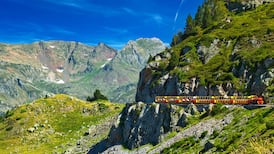Deirdre McQuillanvisits Hotel Monasterio, in Peru
THE ANCIENT INCA city of Cuzco, high in the Andes, is best known as the gateway to Machu Picchu and the well-worn Inca Trail. It is one of the most-visited sites in Latin America, justly famous for its mix of Inca and colonial Spanish architecture. Today, it is home to 500,000 people, and crowded with tourists, mostly backpackers and trekkers, and chock-a-block with hotels, hostels and street hawkers.
One of the most beautiful and cloistered places to stay is a 16th-century Spanish monastery now run as a five-star hotel by Orient-Express in the heart of the city, a few minutes from the lively central square, Plaza de Armas.
Originally built in 1592 on the site of an Inca palace, the monastery and its seminary, San Antonio Abad, were seriously damaged in 1650 by an enormous earthquake.
Part of the restoration included the building of a splendid baroque chapel, with an awesomely elaborate gilded altar surrounded by gold-plated framed paintings, that is now used for the occasional wedding or conference.
For more than a century the seminary was a royal pontifical university. It’s in a lovely, quiet little square that has a museum of pre-Columbian art, a zany restaurant called Fallen Angel and a knitwear shop of the designer Giuliana Testino, sister of the celebrated fashion photographer Mario Testino.
Padding through the (carpeted) cloisters, which are adorned with magnificent medieval religious paintings of the Cuzco school, was a history lesson in itself; every Monday there is a guided art tour in the hotel. The depiction of silks and saintly finery had me enthralled; piped Gregorian chant in the corridors brought back memories of my days in the school choir, a slightly unsettling experience so far from home.
The entrance to the hotel is breathtaking, as you catch sight of the 300-year-old cedar tree and fountain in the courtyard garden, the magnificent vaulted ceilings of the bar area and the roaring log fire in the huge stone fireplace. My (standard) room was a converted monk’s cell, small but well equipped, with comfortable bed, cotton sheets, multichannel TV, minibar, writing desk, portraits of Virgin and Child and a small balcony overlooking another tranquil courtyard.
The marbled bathroom had a strong wall hairdryer (always appreciated), L’Occitane toiletries and a bath grandly curtained like a window – but why the antitheft hangars? Bottled water at the hand basin and bedside was refreshed daily.
The breakfast in the former refectory was substantial and varied; Peruvian bread, fresh fruits and cheese are excellent. Where monks used to sing is now a quiet, elegant restaurant offering pasta, freshwater and sea fish, seared alpaca loin or Creole-style sauteed beef at about $26 (€21) for a main course.
Abandoned for nearly 50 years, the monastery, which is a historical landmark owned by the diocese of Cuzco, was remodelled as a hotel in 1965 and taken over by Orient-Express 10 years ago.
I found the staff at all times friendly and charming, particularly Liliana Moscoso, who helped me through a bad attack of altitude sickness in the middle of the night. (The charge for emergency oxygen was $65/€50.)
The hotel briefly hit the headlines five years ago when the British DJ John Peel died there – though from a heart attack, not altitude sickness. Where El Monasterio, Calle Palacios 136, Plazoleta Nazarenas, Cuzco, Peru. 00-51-84-604000, www.monasterio.orient- express.com.
WhatFive-star hotel in the heart of Cuzco.
Rooms109, as well as 12 junior suites, a deluxe suite, three presidential suites and two royal suites. Oxygen-enriched rooms, which help prevent ill effects from altitude sickness, cost an extra $40 (€31) plus a 10 per cent per night surcharge.
Best ratesA classic room starts at about €410 per night. Bookings on www.monasterio.orient- express.com or 00-44-845-0772222.
AmenitiesRestaurant, bar, 24-hour room service and internet facilities (free for the first 30 minutes, then $10/ €7.75 an hour), boutiques.









